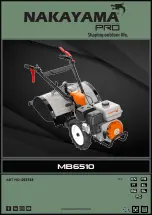
MNL_Standard-NoSpecs_ACWC-18to240-E-_(0713).docx
- 17 -
7.
Motor defective.
7.
Check motor winding for open or short. Replace
motor/pump, if necessary.
VOLTAGE IMBALANCE
1.
Voltage Imbalance over 2% - Incoming Power
- (Check Voltage at front and backside of each
contactor during operation.)
1.
Main Incoming Voltage –
- A voltage imbalance may be an indication of loose
wires/cable connections or faulty contactors.
- Another issue may be the components
themselves. Troubleshoot if needed.
(2)
- If the supply voltage phase imbalance
is still more than 2%, issue may require
contacting local electric utility
company.
2.
Voltage Imbalance over 2% - Load Power
- (Check Voltage at front and backside of each
contactor during operation.)
2.
Main Incoming Voltage –
- A voltage imbalance may be an indication of loose
wires/cable connections or faulty contactors.
- Another issue may be the components
themselves. Troubleshoot if needed.
- If the supply
TEMPERATURE CONTROLLER ERROR
1.
Temperature indication not accurate.
1.
Verify temperature sensor is in good condition and
mounted properly.
- Adjust the offset (typically it is only adjusted a
few degrees.)
2.
Temperature indication or sensor error on
controller.
2.
FOR TEST PURPOSES ONLY!
-
Turn system off. Disconnect power.
-
Disconnect the thermocouple wires from
controller.
-
Connect a short length of copper wire
between the two contacts on the controller.
-
Reconnect power. Turn system on.
-
If the controller “actual” is close in range to
the ambient temperature of the controller,
then the thermocouple is bad. – Replace the
thermocouple.
-
If the controller “actual” is not in range to the
ambient temperature of the controller, then
the thermocouple may be good, the controller
may have internal issues. – Replace the
controller or thermocouple input device.












































